Using the Test Administrator Interface
Scheduling a Test Session
Test sessions can be scheduled only after the testing window has opened. Sessions can be scheduled for any date within two weeks from the current date. Take the following steps to schedule an assessment in advance:
- Log on to the Test Administrator Interface.
-
Select the [Upcoming Sessions] tab and then a button to schedule a session, either in-person or remote (figure 1).
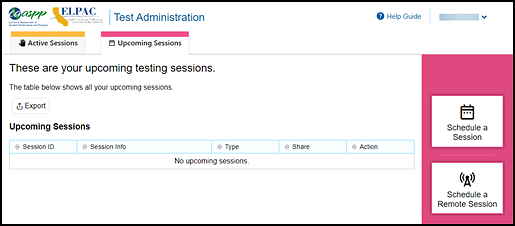
Figure 1. [Upcoming Sessions] tab with the scheduling buttons
- Select the start and end date for the future test session and then the [Next] button.
-
Choose the testing category of the assessment to schedule. An example of the Operational Test Selection screen showing the testing categories is presented in figure 2.
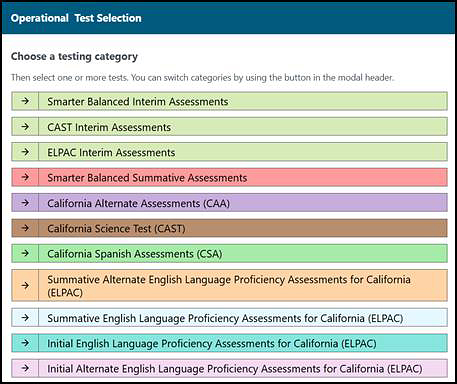
Figure 2. Operational Test Selection screen
-
Select the plus-sign [Expand] icon to expand the options for the exact grade and name of the assessment students will take (figure 3). Assessment categories are separated by color and identified by name.
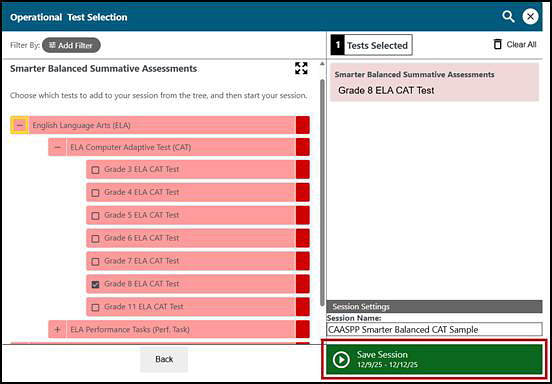
Figure 3. Expanded assessments in the Operational Test Selection screen
-
In the “Session Settings” section in the lower-right corner, enter a session name and then select the [Save Session] button. A Session Information pop-up box appears, providing the session ID and session link (figure 4).
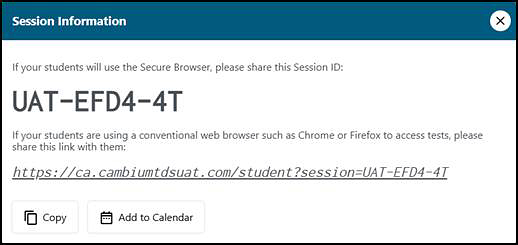
Figure 4. Session Information pop-up box with session ID
- Edit or delete the session in the days prior to the scheduled session date. Note the following about this action:
- Session information is not editable on the day of the session.
- The edit function permits changing the date or selecting additional assessments to add to the testing session.
- Only the session type cannot be edited.
- To switch from an in-person session to a remote session or vice versa, delete the session and recreate it with the correct session type.
In-person test sessions are scheduled and administered separately from remote-testing sessions. This allows student results to be categorized and reported correctly.
Looking Up Students
The TA or TE can use the student lookup feature to perform a quick or advanced search for student information. This is useful if students signing in to the test session cannot remember their logon information. The student must enter a first name exactly as it appears with the student lookup tool. If the first name contains a space or a special character, it must be entered as it appears. (Refer to the guidelines in the Step 1: Signing a Student In subsection for information about entering Unicode characters for special characters such as accented letters.)
To perform a quick search:
- In the banner at the top of the Test Administrator Interface (figure 5), select the [Student Lookup] tab.
-
Enter a student’s full SSID in the SSID field and select the [Search] magnifying glass [
 ] icon. Quick Search results appear below the search field (refer to figure 5).
] icon. Quick Search results appear below the search field (refer to figure 5).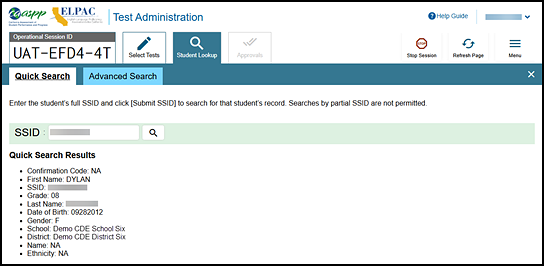
Figure 5. Student Lookup: Quick Search
To perform an advanced search:
- Select [Student Lookup] > [Advanced Search].
- Select the appropriate LEA and school from the District/School drop-down lists.
- Select the appropriate grade level.
- Optional: Enter all or part of a student’s first or last name. If there are special characters in the student’s first or last name, refer to the guidelines in the Step 1: Signing a Student In subsection for information about entering Unicode characters.
-
Select the [Search] magnifying glass [
 ] button. Advanced Search results appear to the right of the search fields (refer to figure 6).
] button. Advanced Search results appear to the right of the search fields (refer to figure 6).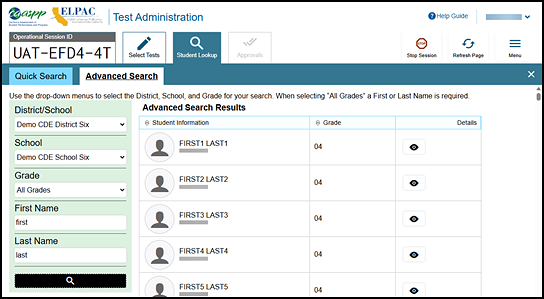
Figure 6. Student Lookup: Advanced Search
- To view a student’s information, select the [View] eye [
 ] icon in the Details column.
] icon in the Details column.
Approving Print Requests
A student using the print-on-demand tool can request printouts of test passages and questions. When the student sends print requests, the request notification appears in the Tests with potential issues table. The print-on-demand designated support must be assigned in the test settings in TOMS.
To approve print requests:
-
Select the [Print] printer [
 ] icon in the Actions column of the Tests with potential issues table. The Student Print Request window appears (figure 7).
] icon in the Actions column of the Tests with potential issues table. The Student Print Request window appears (figure 7).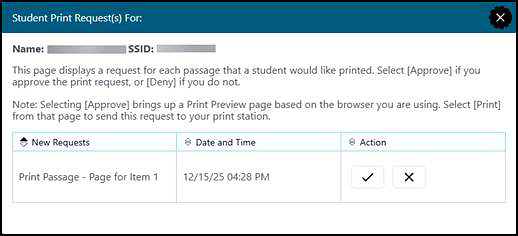
Figure 7. Student Print Requests window
- Review the print request and take one of the following actions in the Student Print Request window (figure 7):
- To approve the request, select the [Approve] check mark [
 ] icon in the Action column. A cover sheet appears in a new browser window.
] icon in the Action column. A cover sheet appears in a new browser window. - To deny the request, select the [Deny] “X” [
 ] icon in the Action column. In the window that appears, enter a brief reason for denying the request and select the [Deny] button. Do not proceed to step 3.
] icon in the Action column. In the window that appears, enter a brief reason for denying the request and select the [Deny] button. Do not proceed to step 3.
- To approve the request, select the [Approve] check mark [
- A printer dialog box opens with a cover page and the items that were selected to print.
- Select [Print] to print the requested test elements.
Viewing Approved Requests
The TA or TE can view a list of every print request approved during the current session.
To view approved requests:
-
Select Print Requests from the Menu drop-down list (figure 8).

Figure 8. Print Requests option in the Test Administrator Interface
-
The Print Requests window opens, listing print requests by student. To print the list of approved requests, select the [Print] button (indicated in figure 9).
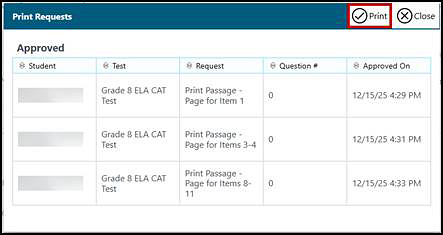
Figure 9. Print Requests window
Making a Record of Test Session Information
The TA or TE can either print a snapshot of the Test Administrator Site as it currently appears if a hard-copy record of the session ID or list of approved students is wanted; or download a spreadsheet with this information after stopping the session. A TA or TE can address any concerns or questions about testing statuses with their site CAASPP coordinator.
Take these steps to print a snapshot of the screen during or after testing:
- In the banner at the top of the Test Administrator Interface, select the [Print Session] printer [
 ] icon. The device’s print dialog window appears.
] icon. The device’s print dialog window appears. - Select the required print settings and then select the approval button ([Print] or [OK], depending on the web browser).
When the TA or TE selects the [Stop Session] button, an option to download a spreadsheet of the final test session details becomes available. Details in the spreadsheet are as follows for each student in the test session:
- Name
- SSIDs
- Test name
- Progress in the assessment
- Testing status
- Test settings status (default or custom)
- Status of students listed in the Tests with potential issues table (Statuses can include whether the student timed out of the assessment or if the student has an outstanding print-on-demand request.)
Take these steps to export the details of the stopped session to a spreadsheet:
-
Select the [Export] button above the Tests table (indicated in figure 10)—there is a button for the Tests without issues table and for the Tests with potential issues table.

Figure 10. [Export] button in the Test Administrator Interface
- Retrieve the file from the Download folder or other default downloading location.
Pausing a Student’s Assessment
Steps
The TA or TE can pause a student’s assessment via the Actions column in the Tests table (refer to figure 11). For information about pause rules, refer to the Pause Rules subsection.

Figure 11. [Pause] button in the Test Administrator Interface
To pause an individual student’s assessment:
- Alert student(s) the assessment is being paused.
- In the Actions column, select the [Pause] double-line [
 ] icon for a student (figure 11).
] icon for a student (figure 11). - Select [OK] to confirm. The TA or TE logs the student off, and an information button appears in the Actions column.
Pause Rules
Multiple-Choice and Technology-Enhanced Items
The pause rules here apply to the CAT (non-PT) portion of the Smarter Balanced, CAST discrete item blocks, and the CSA. Refer to appendix E, scenario 2, item c for additional information about pause rules.
- If an assessment is paused for 20 minutes or less, the student
- is required to log back on to the student interface using the student’s logon information (name, SSID, and test session); and
- will be permitted to review or change responses to any items on prior pages of that segment that had received a response.
- If an assessment is paused for more than 20 minutes, the student
- is required to log back on to the student interface using the student’s logon information (name, SSID, and test session);
- is presented with the page containing the item(s) the student was working on when the assessment was paused (if the page contains at least one item to which there is not a response) or with the next page (if all items on the previous page were answered); and
- will not be permitted to review or change any items on prior pages of that segment that had received a response.
- Highlighted text and notes entered on the digital notepad are item specific and, although they will be saved when an assessment is paused regardless of how long the assessment is paused, they cannot be accessed for items that would not be accessed to the student based on the pause rules.
- In the event of a technical issue (for example, power outage or network failure), students will be logged off and the assessment will automatically be paused. If the technical issue was outside the control of the TA and the pause was longer than 20 minutes, the CAASPP coordinator will need to submit a STAIRS case for a technical issue to allow students to revisit previous questions in that segment. The students will need to log on again to resume the assessment. Highlighted text will be available when the student has logged back on and resumed testing. However, notes entered on the digital notepad—the tool used to make notes about an item—will no longer be available.
- Refer to Appendix E: CAT Pause Rule Scenarios to review the rules that govern pausing during the assessment.
PTs
During the PT portion of the Smarter Balanced and CAST assessments:
- There are no pause restrictions. If a PT is paused for more than 20 minutes, the student can return to the section and continue to enter responses.
- For the mathematics PT, any highlighted text and notes on the digital notepad will not be saved when an assessment is paused regardless of how long the assessment is paused.
- Note the following regarding the ELA PT global notes used during ELA PTs in which students complete a full write, as well as for any other test items within the PT:
- Global notes are retained across items and segments regardless of pause rules.
- Any highlighted text and notes within the global notes will be saved when an assessment is paused regardless of how long the assessment is paused.
- In the event of a technical issue (for example, power outage or network failure), comments entered will be available when the student has logged back on and resumed testing.
There are recommendations for breaks in the Duration and Timing Information subsection. Note that, although CAST is a single assessment that is estimated to take two hours, there are break recommendations, because each PT should be completed in a single session.
CAAs
For the CAAs for ELA, mathematics, and science, the pause rules that follow apply regardless of whether the student or the TE pauses the assessment or there was a technical issue (for example, power outage or network failure) that resulted in the student being logged off.
- The CAAs can be paused and resumed as many times as necessary to allow the student to show what they know. The student also may choose to pause and resume over the course of a day or days throughout the testing window.
- The TE can make the decision to pause and resume the test administration if the student is no longer engaged, is not actively participating, or is showing signs of behavioral or functional concerns related to the assessment.
- When an assessment is paused, the TE, on behalf of the student, must log back on to resume testing. Upon resumption, the student is directed automatically to the first page that has an unanswered item. Previously answered items can be revisited within the current test stage, but not in prior stages.
Students typically take approximately 95 cumulative minutes or less to successfully complete a single content area of a CAA for ELA or mathematics. A student should be given as many breaks as needed to perform well, including testing over multiple days.
If the TE determines it is in the student’s best interest to end the assessment early, the TE will need to advance through the remaining test items until they reach the end, and then submit the assessment.
CSA CR Items
For the CSA, when pausing more than 20 minutes during a CR item (that is, speaking response item or full-write item), the TDS will consider the partial response to be complete. The student will not be able to return to complete that item.
For the speaking domain, a student’s response begins when the student selects the [micrófono] button. For the writing domain, a student’s response begins when the student types any character into the text field, even if that character is deleted.
Test Time-Out (Due to Inactivity)
As a security measure, students, TAs, and TEs are automatically logged off the assessment after 30 minutes of inactivity. For students, activity is defined as selecting an answer or navigation option in the assessment (for example, selecting [Next] or [Back] or using the Questions drop-down list to navigate to another item). Moving the mouse or selecting an empty space on the screen is not considered activity. This time-out also results in the assessment being paused automatically.
For TAs and TEs, activity means that a student or students are registering test activity. As long as students are testing, the TA or TE will not be logged off.
Before the secure browser logs the student off the assessment, a warning message will be displayed on the screen (figure 12). If the student does not select [OK] within 30 seconds after this message appears, the student will be logged off. Selecting [OK] will restart the 30-minute inactivity timer.
![Test timeout warning message that reads, "Are you still there? Click OK to continue or you will be logged out in 30 seconds. [Message Code: 10906]."](/s/caaspp-otam/administering-to-students/using-the-ta-interface/2025-7d-image020.png)
Figure 12. Test time-out warning message
Enabling Screen Saver Mode
Because the student test progress tables in the Test Administrator Interface may contain sensitive student information, such as SSIDs, a built-in screen saver will activate to protect the data. The screen saver can be manually activated by the TA or TE, or it will activate automatically after five minutes of inactivity in the Test Administrator Interface. It turns off when the TA or TE returns the device’s focus to the web browser window by, for example, moving a mouse’s cursor over it. It will also turn off automatically if the test session times out due to TA, TE, or student inactivity.
The screen saver masking hides data from view and shows the session ID, as presented in figure 13. When students are awaiting approval when the screen saver is active, this information is included under the session ID.
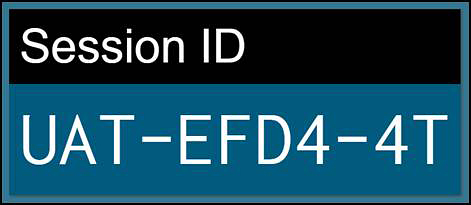
Figure 13. Sample session ID in the Test Administrator Interface screen saver
The TA or TE can turn the screen saver on manually by selecting the Toggle Screensaver option from the Menu drop-down list. The Toggle Screensaver option is indicated in figure 14.

Figure 14. Toggle Screen Saver option
Transferring a Test Session
The TA or TE can transfer an active test session from one device or web browser to another without stopping the session or interrupting in-progress assessments. This is useful in scenarios when a device malfunctions while a session is in progress.
The TDS ensures that the TA or TE can only administer a test session from one web browser at a time. If the TA or TE moves a test session to a new device, the TA or TE cannot simultaneously administer the session from the original web browser or device.
These instructions apply to both the Test Administrator Interface and Test Administrator Training Site. Additionally, the TA or TE cannot transfer a session from the Test Administrator Interface to the Test Administrator Training Site or vice versa.
To transfer a test session to a new device or web browser:
-
While the session is still active on the original device or web browser, log on to the Test Administrator Site on the new device or web browser. The [Active Sessions] tab appears, listing the active session (figure 15).
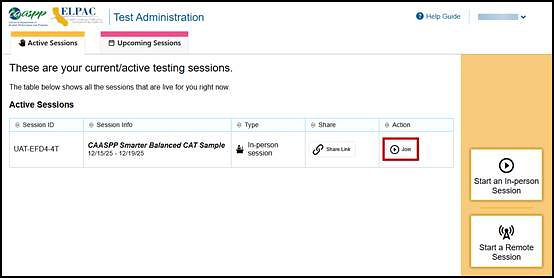
Figure 15. [Active Sessions] tab in the Test Administrator Interface
- Select [Join]. The test session screen appears, allowing the TA or TE to continue monitoring students’ progress. The test session on the previous device or web browser automatically closes.
Testing Over Multiple Sessions or Days
Refer to the Duration and Timing Information subsection for estimated testing times and estimated test durations.
Smarter Balanced Assessments, CAST, and the CSA
For some assessments, particularly the Smarter Balanced PTs and the optional CSA, students may be best served by sequential, uninterrupted time that may exceed the time in a student’s schedule. Smarter Balanced recommends that the ELA PT be administered in two sessions, corresponding with Part 1 and Part 2. Students can be provided breaks within each part; however, once a student moves on to Part 2, the student will not be able to review or revise items in Part 1. For this reason, it is recommended that students complete Part 1 in one test session; Part 2 would ideally be delivered the next school day. For the mathematics PT, Smarter Balanced recommends that it be administered in one test session of 40–120 minutes.
For the CSA, given the total estimated testing time—approximately four to four-and-one-half hours—it is recommended to administer the CSA over multiple sessions spanning several days.
If the TA intends to administer an assessment over the course of multiple days for a student or group of students, the TA may ask students to pause at a designated point. There is nothing built into the system to prevent students from progressing from one item or segment of the assessment to another. The TA should give the students clear directions on when to pause and be made aware that they will not be able to return to any partially completed CR items after a pause of more than 20 minutes. This guidance may be written on a dry-erase board, chalkboard, or another place to which students can easily refer.
Students will receive a notification when they reach the end of the segment or the assessment, similar to the notification shown in figure 16.
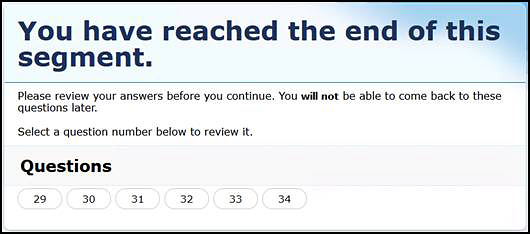
Figure 16. Sample End Segment screen
When testing is resumed on a subsequent day, the TA will need to start a new test session and provide a new session ID. When instructing the students to log on, TAs must read the unitalicized sections of the general script (SAY statements) to the students from the beginning.
CAAs
Students typically take approximately 60 to 100 cumulative minutes or less to successfully complete a single content area—ELA, mathematics, or science—of a CAA. If at any time the TE administering the assessment feels the student is no longer engaged in the assessment, is not actively participating, or is showing signs of behavioral or functional concerns related to the assessment, the TE can make the decision to pause or end the assessment. If the choice is made to pause the assessment, the student can reenter and complete testing once settled, or when the TE feels it is appropriate. If the decision is made to end the assessment based on the best interests of the student, the TE will need to advance through the remaining test items, reach the [Submit Test] button, and submit the assessment.
Managing Test Expiration
“Opportunities” refers to the number of times a student can take an assessment within a range of dates. A student’s test opportunity remains active until the student submits the assessment or until the opportunity expires. Once an assessment opportunity expires, the student cannot complete or review the assessment unless a Reopen Appeal is granted. Note the following about test expiration:
- Students have one opportunity per summative CAASPP computer-based assessment.
- All assessments with registered responses to any item will submit automatically if the assessment has expired.
- Only interim assessments offer students multiple opportunities.
Smarter Balanced CAT Items, CAST, the CAAs, and the CSA
A student’s Smarter Balanced CAT, CAST, CAA for ELA, mathematics, or science, or CSA remains active until the student completes and submits the assessment or 45 calendar days after the student has begun the assessment (but before the end of the testing window), whichever occurs sooner. However, it is recommended that students complete the CAT items portion of the assessment, CAST, or the CSA within five days of starting the designated content area.
Note that each of the three embedded PTs in the CAA for Science are treated as separate assessments and should be administered immediately following instruction on the related content throughout the instructional year. Assessments must be completed and submitted no later than the last day of the LEA’s instructional calendar or June 30, whichever comes first.
Smarter Balanced PT
The Smarter Balanced PT is a separate assessment that remains active for no more than 15 calendar days after the student has begun the PT. However, Smarter Balanced recommends that students complete the PT in each content area within three days of starting. A summary of recommendations for the number of sessions and session durations is provided in subsection Duration and Timing Information.

